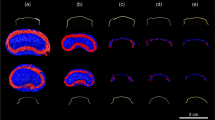Abstract
Background:
In a previous investigation we reported on magnetic forces in the static magnetic field of a 1.5 Tesla MRI system. The aim of the present investigation was to assess forces on orthodontic wires in a high field strength MRI system at 3 Tesla.
Materials and Methods:
Thirty-two different orthodontic wires (21 archwires, eight ligature wires and three retainer wires) were investigated in a 3 Tesla high field strength MRI system (Intera, Philips Medical Systems, Best, The Netherlands). Translational forces were measured by the deflection angle test (ASTM F2052-02), and rotational forces assessed on a 5-point qualitative scale.
Results and Conclusion:
Translational forces ranged between 43.5 mN and 136.1 mN for retainer wires and between 0.6 mN (Noninium®) and 208.4 mN (Orthos™ StaStainless Steel) for steel archwires. Translational forces were up to 53.8 times as high as gravitational forces for retainer wires and up to 54.5 times as high for steel archwires, associated with marked rotational forces for the most part. Archwires manufactured from nickel-titanium, titanium-molybdenum and cobalt-chromium and different ligature wires showed no or negligible forces in the magnetic field. Carefully ligated wires should not present a risk due to translational and rotational forces in the high field MRI system at 3 Tesla.
Zusammenfassung
Hintergrund:
In einer vorangegangenen Untersuchung wurde bereits über im statischen Magnetfeld eines 1,5-Tesla-MRT-Systems wirkende Kräfte berichtet. Ziel dieser Untersuchung war nun die Darstellung und Beurteilung der auftretenden Kräfte während Hochfeld-Magnetresonanztomographie bei 3 Tesla.
Material und Methodik:
Es wurden 32 verschiedene kieferorthopädische Drähte (21 Drahtbögen, acht Ligaturendrähte und drei Retainerdrähte) in einem 3-Tesla-Hochfeld-MRT-System (Intera, Philips Medical Systems, Best, Niederlande) untersucht. Die Messung der auf die Drähte wirkenden Translationskräfte erfolgte mittels Fadentest (ASTM F2052-02), die Evaluierung der Rotationskraft wurde qualitativ anhand einer 5-Punkte-Skala vorgenommen.
Ergebnisse und Schlussfolgerung:
Die Messungen der Translationskräfte auf die Retainerdrähte ergaben zwischen 43,5 und 136,1 mN und auf die Stahl-Drahtbögen zwischen 0,6 mN (Noninium ®) und 208,4 mN (Orthos™ Stainless Steel). Die ermittelten Translationskräfte betrugen damit bei den Retainerdrähten bis zum 53,8fachen und bei den Stahl-Drahtbögen bis zum 54,5-fachen der auf diese Objekte wirkenden Gravitationskräfte, verbunden mit größtenteils ausgeprägten Rotationskräften. Translations- und Rotationseinflüsse auf Nickel-Titan-, Titan-Molybdän- und Kobalt-Chrom-Drahtbögen sowie auf verschiedene Ligaturendrähte waren nur gering oder nicht vorhanden. Im 3-Tesla-Hochfeld-MRT-System ist bei einer sorgfältigen Befestigung von kieferorthopädischen Drähten nicht von einer Gefährdung durch magnetische Kräfte auszugehen.
Similar content being viewed by others
Author information
Authors and Affiliations
Corresponding author
Rights and permissions
About this article
Cite this article
Klocke, A., Kahl-Nieke, B., Adam, G. et al. Magnetic Forces on Orthodontic Wires in High Field Magnetic Resonance Imaging (MRI) at 3 Tesla. J Orofac Orthop 67, 424 (2006). https://doi.org/10.1007/s00056-006-0621-x
Received:
Accepted:
DOI: https://doi.org/10.1007/s00056-006-0621-x




